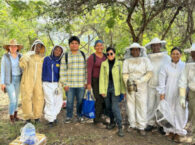Improving Energy Efficiency at Juda School
Metrics
Community
Green CountyCommunity Size
44,411University
University of Wisconsin - MadisonProgram
UniverCity YearCase Type
Project StoriesFocus Areas
EquityDiscipline
EngineeringRegion
EPA Region 5, USAUniversity Department Code
EngineeringSustainable Development Goals
07 Affordable and Clean EnergyPopulation Type
YouthThe following document describes a project undertaken in conjunction with the UniverCity Year in which we, a group of 4 UW-Madison students, worked with the Juda School
in order to improve their energy efficiency. Juda is a K through 12 school located in southern WI
that is seeking to be more sustainable, an effort led by Juda educator Scott Anderson. While Juda
has taken many steps toward sustainability, including installing a 7.5kW solar array, there is
room for improvement, and finding that “room” as economically and efficiently as possible was
the main objective of this venture. Our client, Scott, specifically requested that we aim for the
“low-hanging fruit” solutions–that is the cheapest possible solutions that would make an impact.
We determined that any energy-idea that we recommended to Juda would have to be practical,
economical, and politically feasible given that any major changes made at Juda would require
district approval. Ultimately we have come up with a list of 10 possible solutions that, if
implemented, will save Juda energy and money.
Proposed solutions fall into two categories: behavioral and structural. Behavioral
solutions were heavily emphasized as they are very inexpensive compared to their structural
counterparts. Additionally, Scott expressed a desire to begin cultural change at Juda in regards to
sustainability, as, in his opinion, school-wide energy saving behaviors were severely lacking. In
this spirit, two behavioral solutions are aimed at instigating long term change at Juda. The first is
the Cool Choices program which uses friendly competition and an interactive game to instill
good habits in staff and students that will continue to save energy even after the game ends. The
second is to institute stickers above every light switch that gently remind the last person to leave
a room to turn off the light. These slight changes in behavior save a surprising amount of energy.
The other behavioral solutions are one-time changes that will save energy moving forward,
including lowering sleep settings on school computers and other electronics and using smart
2
power strips to eliminate phantom energy consumption when teacher workstations are not in use.
All of these behavioral solutions cost very little–two are even free–thus demonstrating the
benefit of this type of intervention.
The portion of our recommendations with the biggest energy saving potential, as well as
the biggest budget, are the structural solutions. The benefit of these solutions, in addition to the
obvious advantage of saving large quantities of energy, is that once they are implemented, they
require little further effort: all 6 structural solutions have a lifetime of at least 10 years. These
solutions include external building improvements, such as roof coating and window insulation,
as well as modifications of current Juda systems, such as HVAC insulation and modification of
occupancy sensor time reductions. Some of the most impactful solutions, however, involve the
addition of new appliances including replacing the remainder of Juda’s non-LED lights with
LEDs and installing occupancy sensors in the rooms that currently lack them. Though some of
these solutions have a high price tag, the benefits they return outweigh the initial cost, with
payback periods within the lifetime of the product. Included in this report is one solution, the
installation of smart thermostats, that is not currently feasible at Juda, but has been included for
potential future application if the opportunity should arise.
The combination of all of these proposed solutions could reduce Juda’s energy
consumption, taking both electricity and gas into account, by 8.5 percent. Considering in the last
year Juda consumed over 2,365,000 kWh, this is a significant improvement. We hope that Juda
can use these solutions going forward in their pursuit of sustainability.
Read the final student report delivered to the local gov/community partner.
UniverCity Year Contact Info
Gavin Luter
Managing Director
gavin@cows.org
608-261-1141
University Faculty Contact
Scott Williams
Civil and Environmental Engineering
spwilliams@wisc.edu
Local Government / Community Contact
Scott Anderson
Teacher at Juda School


